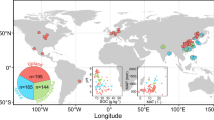Abstract
Microbial communities of recent surface soils and the soils buried beneath the rampart of the Tsaritsyn Defense Line (1718–1720) in the Little Ice Age were studied. The contribution of the time factor to the variability in the number of microorganisms from different trophic groups was shown to be minor (0.2–0.3%), although significant. In the upper horizon of the paleosols reflecting the environmental conditions intrinsic to the period of the rampart construction, the lower (by two times) content of live microbial biomass, the lower metabolic activity of the microbial community, and the more contrasting changes in the microbiological parameters as compared to these characteristics in the recent soils were found for all the elements of the local topography. The stabilities of the microbial communities in the buried and recent soils were almost the same. The ecological–trophic structure of the microbial communities in the buried soils evidences that, the climate of the 18th century in the southern Privolzhskaya Upland was more humid than now. At the same time, temperature conditions of the Little Ice Age did not prevent the development of steppe vegetation and corresponding soil microbial communities in this area. Our data on the morphology and physicochemical properties of the soils confirm the assumption about more humid climatic conditions at the beginning of the 18th century in the studied area.
Similar content being viewed by others
References
E. V. Arinushkina, Manual ohe Chemical Analysis of Soils (Moscow State University, Moscow, 1970) [in Russian].
E. V. Blagodatskaya and N. D. Anan’eva, “Assessment of the resistance of soil microbial communis to pollutants,” Eurasian Soil Sci. 29 (11), 1251–1255 (1996).
O. V. Bukharin, A. L. Gintsburg, Yu. M. Romanova, and G. I. El-Registan, Sural Mechanisms of Bacteria (Meditsina, Moscow, 2005) [in Russian].
M. B. Vainshtein and E. B. Kudryashova, “Nannobacteria,” Microbiology (Moscow) 69 (2), 1138 (2000).
T. S. Demkina, A. V. Borisov, and V. A. Demkin, “Microbiological study of paleosols buried under Kurgans in the desert-steppe zone of the Volga-Don interfluve,” Eurasian Soil S 37 (7), 743–748 (2004).
T. S. Demkina, V. A. Demkin, and A. V. Borisov, “Microbial communitiin the paleosols of archaeological monuments in the desert-steppe zone,” Eurasian Soil Sci. 33 (9), 978–986 (2000).
T. S. Demkina, A. V. Borisov, M. V. El’tsov, and V. A. Demkin, “Comparae characterization of microbial communities in kurgans, paleosols buried under them, and background surface soils in the steppe zone of the Lower Volga region,” asian Soil Sci. 40 (6), 665–674 (2007).
T. S. Demkina, T. E. Khomutova, A. V. Borisov, and V. A. Demkin, “Microbiological study of paleosols bur under kurgans in the valley of Ilovlya River,” in Archeological Data on Volga-Don Steppes (Volgograd State University, Volgograd, 2004), No. 2, pp. 87–95.
D. G. Zvyagintsev, I. V. Aseeva, I. P. Bab’eva, and T. G. Mirchink, Practical Manual on Soil Microbiology and Biochemistry (Moscow State University, Moscow, 1980) [in Russian].
N. N. Kashirskaya, Candidate’s Dissertation in Biology (Voronezh, 2006).
Climate Fluctuations over Last Cury, Ed. by E. P. Borisenkova (Gidrometeoizdat, Leningrad, 1988) [in Russian].
D. I. Nikitin and E. S. Nikitina, Self-Purification of Environment and Parasites of Bacteria (Genus Bdellovibrio) (Moscow, 1978) [in Russian].
A. Yu. Salamakhin, MSc Thesis in Biology (Pushchino, 2011).
E. Z. Tepper, Microorganisms of Genus Nocardia and Humus Decomposition (Nauka, Moscow, 1976) [in Russian].
A. M. Tyurin, “Dating of Small Ice Age,” Nov. Khronologiya, No. 5, (2007). http://new.chronologia.org/volume5/tur_mlp.html
T. E. Khomutova and V. A. Demkin, “Assessment of the microbial biomass using the content of ppholipids in soils of the dry steppe,” Eurasian Soil Sci. 44 (6), 686–692 (2011).
J. P. E. Anderson and K. H. Domsch, “A physiological method for the quantitative measurement of microbibiomass in soils,” Soil Biol. Biochem. 10 (3), 215–221 (1978).
COHORT Software, v. 4.21, 1986, (Berkely, CA, 1990).
T. S. Demkina, T. E. Khomutova, N. N. Kashirskaya, et al., “Age anctivation of microbial communities in soils under burial mounds and in recent surface soils of steppe zone,” Eurasian Soil Sci. 41 (13), 1439–1447 (2008).
Author information
Authors and Affiliations
Corresponding author
Additional information
Original Russian Text © T.S. Demkina, T.E. Khomutova, T.V. Kuznetsova, A.A. Kontoboitseva, A.V. Borisov, 2016, published in Pochvovedenie, 2016, No. 1, pp. 65–78.
Rights and permissions
About this article
Cite this article
Demkina, T.S., Khomutova, T.E., Kuznetsova, T.V. et al. Microbial communities of buried soils of the Tsaritsyn Defense Line (1718–1720). Eurasian Soil Sc. 49, 56–69 (2016). https://doi.org/10.1134/S1064229315090021
Received:
Published:
Issue Date:
DOI: https://doi.org/10.1134/S1064229315090021




